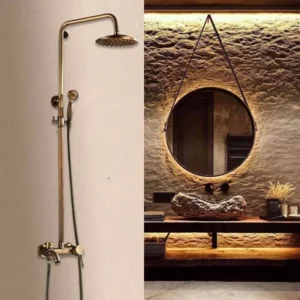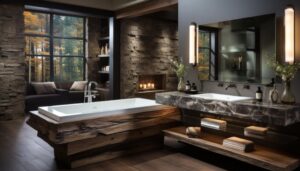The bathroom fixtures industry is witnessing significant changes, with new trends emerging in the wholesale bathtubs and showers market. Procurement officers must stay informed to make strategic purchasing decisions. This article explores the latest trends and innovations shaping the industry.
The latest trends in wholesale bathtubs and showers include compact designs like corner tubs and Japanese-style soaking tubs, luxurious materials such as natural stone and copper, and advanced features like anti-slip surfaces and easy-clean coatings. These trends focus on maximizing space, enhancing aesthetic appeal, and ensuring safety and convenience.
As these trends evolve, understanding their implications can help procurement officers stay ahead in the market.
What is the most popular bathtub style?
Freestanding bathtubs remain a favorite due to their versatility in modern and classic designs. They offer a blend of style and functionality, making them a go-to choice for many high-end projects. Other styles gaining popularity include:
Natural Wood Bathtubs: Offering a unique aesthetic, wood bathtubs are becoming a statement piece in luxurious bathroom designs.
Alcove Bathtubs: Ideal for smaller spaces, these tubs fit snugly into three walls, providing a seamless look.
Corner/Whirlpool Tubs: Perfect for maximizing space in a bathroom, these tubs often come with whirlpool features for a spa-like experience.
Walk-in Bathtubs: Increasingly popular in healthcare facilities and among the elderly, these tubs offer safety and ease of use.
What is new in bathtubs?
Let’s get real about what’s new and exciting in the bathtub world. While porcelain and acrylic are like the classic jeans and t-shirts of the bathtub world—always in style—there’s a trend towards more luxurious and unique materials.
Ever heard of stone bathtubs? These are like the Ferraris of bathtubs. Made from marble, granite, or limestone, they’re not just eye candy; they’re built to last and keep the water warm longer. It’s like taking a bath in a piece of art.
Copper bathtubs are also making waves. They’ve got this old-world charm and develop a unique patina over time, kinda like a well-loved leather jacket. Plus, copper has natural antimicrobial properties, so it’s both stylish and smart.
Concrete bathtubs are another trend. Think of them as the industrial chic option. They can be customized in any shape or finish, giving you that bespoke look. They’re tough as nails and can be a real statement piece.
And let’s not forget wood bathtubs. These are like the zen masters of the bathtub world, bringing a slice of nature indoors. Made from treated hardwoods like teak or hinoki, they’re not just pretty faces. They’re designed to handle water and humidity, creating a spa-like experience right in your bathroom.
What sells better, bath or shower?
So, what’s the deal with baths versus showers? Honestly, there’s no clear winner when it comes to resale value. It’s kinda like choosing between chocolate and vanilla—everyone has their preference. Families with young kids often prefer bathtubs because, let’s face it, bathing a toddler in a shower is like trying to wrangle a wet cat.
Younger professionals and older adults tend to lean towards showers for their convenience. A quick shower saves time, and for those with mobility issues, it’s a safer option.
But if you really want to cover all bases, go for a shower-tub combo. This way, you’re not forcing anyone to choose. It’s like having your cake and eating it too. These combos are especially popular in urban areas where space is at a premium. They save space while offering the best of both worlds.
In commercial settings, like hotels, offering both options can enhance guest satisfaction. Imagine checking into a hotel after a long flight and having the option to either take a quick shower or soak in a luxurious bath. It’s these little choices that can make a big difference in guest experience and reviews.
Why are people putting bathtubs in showers?
Now, let’s talk about this trend of combining bathtubs and showers in one space. It sounds a bit like mixing oil and water, but trust me, it works. The idea is all about space efficiency and creating a more open, functional bathroom.
In smaller bathrooms, having a bathtub and shower in the same area can free up floor space, making the room feel larger and more airy. It’s like magic! This setup, often called a “wet room,” involves waterproofing the entire space so you don’t have to worry about water damage.
Design-wise, it’s a game-changer. Imagine a sleek, glass enclosure that separates the wet area from the rest of the bathroom. It’s modern, stylish, and makes cleaning a breeze. No more dealing with shower curtains or multiple doors.
Combining a bathtub with a shower also caters to different preferences. Some people love a quick shower, while others want to relax in a bath. This way, you get both options without needing extra space. It’s especially popular in family homes where different members have different needs.
Wholesale Showers and Shower Kits
With the growing demand for efficient and customizable bathroom solutions, wholesale shower kits are becoming the go-to option. These kits are like the IKEA of showers—everything you need in one package. They simplify the procurement process, ensuring all components fit together perfectly, which means fewer headaches during installation.
Wholesale shower kits typically include the shower pan, walls, doors, and fixtures. This all-in-one approach saves time and reduces the hassle of dealing with multiple suppliers. For procurement officers, it’s a dream come true.
The trend towards modular shower kits is all about personalization and ease of installation. These kits can be tailored to meet specific needs, offering a range of styles, materials, and finishes. Imagine picking out exactly what you need for your project, knowing everything will fit together seamlessly.
Buying these kits wholesale also means significant cost savings. When you buy in bulk, the price per unit drops, allowing businesses to stay within budget without compromising on quality. For real estate developers and contractors, these savings can be passed on to clients, making projects more competitive and attractive.
Bathroom Wholesale Market Trends
Understanding the bathroom wholesale market is crucial. Current trends show a shift towards sustainable and eco-friendly products. Manufacturers are now focusing on creating fixtures that meet high standards of quality and durability while also being environmentally responsible.
This includes using recyclable materials, water-saving technologies, and energy-efficient designs. It’s a response to the growing consumer demand for green building practices. People want products that are not just high-quality but also kind to the planet.
The market is also seeing advancements in technology. Smart bathroom fixtures, like touchless faucets and digital shower controls, are becoming more common. These innovations not only enhance convenience and hygiene but also contribute to overall water and energy savings.
For procurement officers, staying on top of these trends is essential. By sourcing products that align with current demands and future trends, businesses can stay competitive and meet the evolving needs of their customers.
Keeping up with the latest trends in wholesale bathtubs and showers can make a huge difference in procurement decisions. Embracing new materials, designs, and technologies ensures you’re getting high-quality, durable products that meet market demands. By understanding and integrating these trends into your strategies, you can enhance your competitive edge and deliver top-notch bathroom solutions to your clients. The move towards sustainability, advanced technology, and innovative design in bathroom fixtures is setting the stage for a future where efficiency meets elegance.




